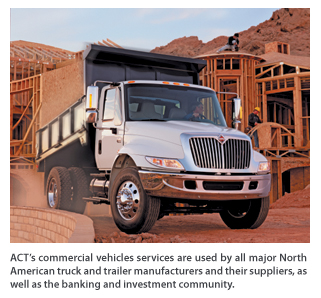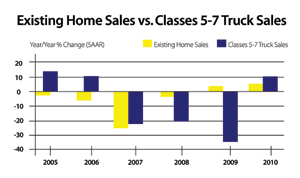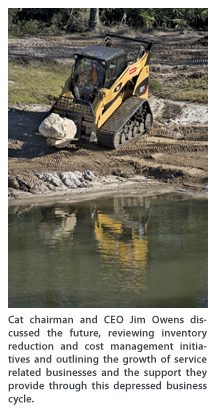Road Conditions
Thanks to a whole host of factors, production and sales of medium-duty trucks are expected to fall again in 2009, according to ACT Research Co. LLC. In the latest release of the ACT N.A. Commercial Vehicle Outlook, ACT forecasts that Classes 5 to 7 medium-duty production will be off 34 percent in 2009 before returning to growth in 2010. Chief among the list of issues behind the lingering downturn is continued weakness in the housing sector. The weakness has directly impacted numerous types of businesses that typically benefit from the construction and sale of homes. Those businesses include, but are not limited to, contractors and builders, building material suppliers, retail stores, utility companies and lease/rental and moving companies.

Like new home sales, sales of existing homes have been grappling to find a bottom, sinking from more than 7 million units (at a seasonally adjusted annual rate) three years ago to under 5 million units in June. Existing home sales have been below the 5 million unit mark for the past 15 months. The chart on page 15 shows the relationship between the sale of existing homes and medium-duty trucks. As the chart illustrates, existing home sales started slowing in 2005, but the truck market continued to expand. It was not until the housing market really crashed in 2007 that truck sales reacted. The commercial vehicle industry is now in a predicament: It has to work off the extra trucks that were put into the marketplace during 2005 and 2006 before it can begin participating in any potential recovery.

ACT is a recognized leading publisher of commercial vehicle industry data, market analysis and forecasting services for the North American market. For more information on ACT, visit www.actresearch.net.
Steve Tam is the vice president of the Commercial Vehicle Sector with ACT Research, based in Columbus, Ind.
Leaner, Sleeker Cat
Caterpillar Chairman and CEO Jim Owens Discusses Future Profit

During the presentations, Owens and his leadership team said that Caterpillar expects profits in the $8 to 10 per share range within five years if the global economy experiences a “normal” recovery cycle. Caterpillar has also implemented plans to generate annual profits of $2.50 per share during future recessionary conditions and its ability to generate significant cash flow has been outlined. Caterpillar’s 2009 outlook for sales and revenues has been reaffirmed in a range of $32 to $36 billion with a 2009 profit range of $0.40 to $1.50 per share including redundancy costs of about $0.75 per share for the year.
“We believe a recovery will come and that Caterpillar will benefit from the world’s need for the products we make,” said Owens. “In the last eight months, Team Caterpillar has demonstrated remarkable agility as we responded to rapid changes in the global economy. Looking forward, there is far too much uncertainty to know when the global economy will turn toward robust positive growth, but no matter what happens, Caterpillar has the people, products, dealer support and strategies to prosper and to support our customers as they make sustainable progress possible in every region of the world.”


Comments are closed here.